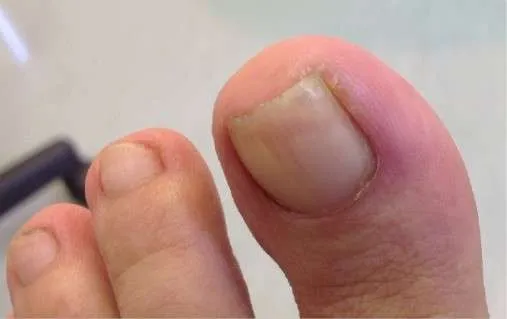How to Get Rid of an Ingrown Fingernail?
How to Get Rid of an Ingrown Fingernail?

Ingrown fingernails are a painful condition that occurs when the edge of the nail grows into the surrounding skin, leading to inflammation, swelling, and discomfort. While ingrown toenails are more common, fingernails can also become ingrown, causing similar issues. Treating an ingrown fingernail promptly is important to prevent infection and relieve pain. This blog will walk you through the causes, symptoms, treatments, and preventive measures for dealing with this condition, with insights from experienced podiatrist Dr. Kris A. DiNucci.
What Causes an Ingrown Fingernail?
Several factors can contribute to the development of an ingrown fingernail:
- Improper Nail Trimming: Cutting the nails too short or at an angle can cause them to grow into the surrounding skin.
- Injury or Trauma: Stubbing or injuring the finger can lead to an abnormal nail growth pattern.
- Nail Biting: Constantly biting or picking at the nails can damage the skin and the nail, increasing the risk of an ingrown nail.
- Tight Gloves: Wearing gloves that are too tight can push the nails into the skin, causing ingrown fingernails.
- Fungal Infections: Infections can change the shape of the nails, making them more prone to becoming ingrown.
Symptoms of an Ingrown Fingernail
The symptoms of an ingrown fingernail are similar to those of an ingrown toenail. Some common signs include:
- Redness and Swelling: The skin around the nail may become red and swollen.
- Pain and Tenderness: Pain may worsen when pressure is applied to the area.
- Pus: In severe cases, pus may accumulate, indicating an infection.
- Nail Deformity: Over time, the nail may become thickened or distorted.
If you notice any of these symptoms, it’s important to treat the condition early to avoid complications.
Home Remedies for Ingrown Fingernails
For mild cases, there are several home remedies that may help alleviate the symptoms of an ingrown fingernail. Here are some steps you can take to treat the condition at home:
- Soak the Affected Finger: Soaking the finger in warm, soapy water for 15 to 20 minutes several times a day can soften the skin and relieve inflammation. Adding Epsom salt to the water can also help reduce swelling.
- Gently Lift the Nail: After soaking, you can try to gently lift the edge of the ingrown nail using a sterile cotton ball or dental floss. This may help the nail grow away from the skin. Be cautious and avoid forcing the nail, as this can cause further damage.
- Apply an Antibiotic Ointment: To prevent infection, apply an over-the-counter antibiotic ointment to the affected area. This can help keep the area clean and promote healing.
- Wear Loose Gloves: If you need to wear gloves, make sure they are loose-fitting to avoid putting pressure on the nails.
- Take Pain Relievers: Over-the-counter pain relievers like ibuprofen or acetaminophen can help manage the discomfort.
When to See a Doctor
If home treatments do not improve the condition within a few days, or if the ingrown nail becomes infected, it’s time to consult a healthcare professional. Infection signs include increased redness, swelling, warmth, pus, or severe pain. In these cases, a doctor may recommend more advanced treatments.
Dr. Kris A. DiNucci, a board-certified podiatrist, emphasizes the importance of seeking medical attention for persistent ingrown nails. Left untreated, the condition can lead to more serious complications, such as a spreading infection or even permanent nail damage.
Medical Treatment for Ingrown Fingernails
For more severe or persistent cases, medical intervention may be necessary. Your healthcare provider may suggest one of the following treatments:
- Partial Nail Removal: In cases where the nail has deeply embedded into the skin, a doctor may need to remove part of the nail. This procedure is typically performed under local anesthesia, and it can provide quick relief from pain and inflammation.
- Drainage of Pus: If the ingrown fingernail has led to the formation of an abscess, the doctor may drain the pus to relieve pressure and allow the area to heal.
- Antibiotics: If an infection has developed, your doctor may prescribe oral or topical antibiotics to clear the infection and prevent it from spreading.
- Matricectomy for Ingrown Toenails: While this procedure is more commonly associated with toenails, some patients with recurring ingrown fingernails may undergo a similar treatment. In a procedure called “ingrown toenail matricectomy,” the nail matrix, the part of the nail that produces new cells, is permanently removed. This prevents the nail from growing back, which can be particularly helpful for chronic cases. Though more common for toenails, this can be applied to fingernails if needed under a doctor’s advice.
Preventing Ingrown Fingernails
Preventing ingrown fingernails is often easier than treating them. Here are some simple tips to help avoid this painful condition:
- Trim Nails Properly: Always cut your fingernails straight across and avoid cutting them too short. Leave a small portion of the white tip intact to prevent the nail from growing into the skin.
- Keep Nails Clean: Maintaining good hand hygiene is essential. Regularly wash your hands and keep your nails clean to prevent infections.
- Avoid Nail Biting: If you have a habit of biting your nails, try to break it. Nail-biting can damage the skin and nails, making them more prone to becoming ingrown.
- Wear Proper Gloves: Make sure any gloves you wear are not too tight. Tight gloves can force the nails into the skin and cause ingrown nails.
- Treat Nail Infections Promptly: If you develop a fungal infection or other nail issues, address them right away to prevent complications like ingrown nails.
Final Thoughts
Dealing with an ingrown fingernail can be uncomfortable, but with proper care and early treatment, you can relieve the pain and prevent infections. If home remedies don’t help, or if the condition worsens, it’s important to consult a medical professional for more advanced treatment options. Dr. Kris A. DiNucci advises that ingrown nails should not be ignored, as they can lead to more serious complications if left untreated.
By following good nail care practices and seeking timely medical attention when necessary, you can avoid the pain and discomfort that come with ingrown fingernails. Whether it’s a minor issue or a more severe case requiring medical intervention, knowing how to get rid of an ingrown fingernail can make a significant difference in your overall hand health.
For those suffering from chronic ingrown toenails or fingernails, procedures like the ingrown toenail matricectomy may offer long-term relief. Always consult with a qualified healthcare provider to determine the best course of action for your specific condition.




